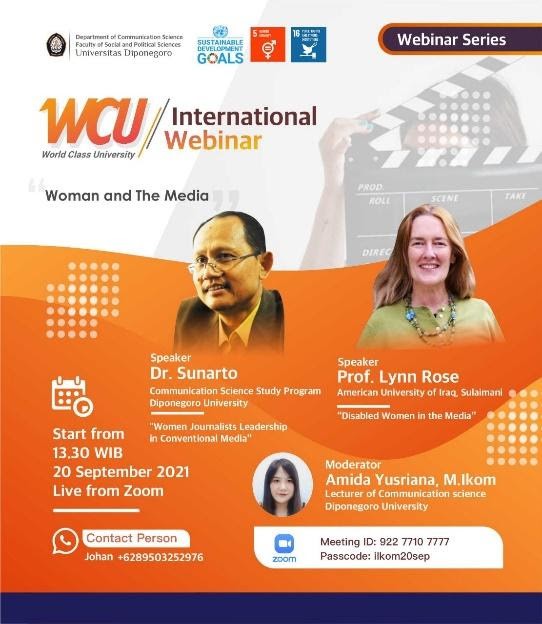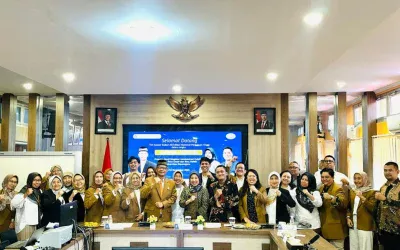Digital Poster of International Webinar: Women and The Media on Monday, 20 September 2021.
Semarang—Department of Communication Sciences held an international webinar on Monday (20/9) at 13.30 WIB through the Zoom Meeting platform which was attended by 184 participants. This webinar raised the topic of Woman and The Media, which was presented by two speakers with academic backgrounds: Dr. Sunarto, a lecturer in Communication Science at Diponegoro University (Undip) and Prof. Lynn Rose, lecturer in Humanities at the American University of Iraq Sulaymani (AUIS). This webinar was guided by Undip’s Communication Science lecturer, Amida Yusriana, M.Ikom as moderator.
Disabled Woman in Media
Prof. Lynn started this webinar with the sub topic “Disabled Women in the Media”. Jess Zimmerman’s quote in her book entitled “Women and Other Monsters” opens this discussion. In the quote it is said that women with different body shapes are a danger sign for men and a warning for women. According to her, untill now it is still happening.
“Throughout human history, women have had to function within a very limited range of aesthetics and behaviors,” Lynn said.
Lynn also discusses how disabled women are portrayed in cinema from time to time. In the 20th century, women with disabilities were portrayed as pitiful but courageous, pathetic and terrible, or simply terrible. For example in the film “Wait Until Dark” (1967), even though the main character who is blind is shown as sympathetic, this film still illustrates how scary it is to be a person with a disability.
Fortunately, from the 1980s to the 2000s, films on disability began to introduce people to new ideas and provide at least some much-needed representation for people with disabilities. In this era, characters with disabilities have more intelligence than others, have a passion for fighting, and are starting to be portrayed positively by cinema.
Continuing into the 21st century, progress has been seen in the portrayal of women with disabilities in the media. There aren’t many blatantly negative stereotypes. The depiction of persons with disabilities is getting better. However, despite not seeing people with disabilities described as sad and terrible, now the public is presented with many beautiful, glamorous, and sexy disabled women in the media.
“This worries me. Do women with disabilities have to look very beautiful? Isn’t this still a male gaze and gaze capable of determining what is acceptable and agreeable? It’s the same as considering women as sexual objects that are only seen from physical beauty,” added Lynn.
Woman Journalists Leadership in Conventional Media
The second sub topic, “Woman Journalists Leadership in Conventional Media” was presented by Dr. Sunarto as the 2nd speaker. Sunarto made a statement that when a female journalist becomes a leader, many parties will doubt their competence. This statement is supported by research results in 2018 which show that the gender gap in Asia is quite high.
“In Indonesia itself, female journalists who work in conventional media, both leaders and ordinary staff, have a lower gap in a fairly large range with male journalists,” said Sunarto.
Sunarto uses several perspectives to analyze this phenomenon. First, from the perspective of mass communication, which according to his presentation, focuses on how messages are used within the organization. Second, viewed from the perspective of gender communication, namely the media as a sender of messages to the public.
“The media is dominated by capitalism and men, so the messages are often very patriarchal,” he added.
The last perspective, based on standpoint theory, is that the social situation in several locations also shows the existence of a hierarchy in the organization.
Writer: Dinda Khansa
Reporter: Salsabila Febryanti
Editor: Annisa Qonita Andini





0 Comments